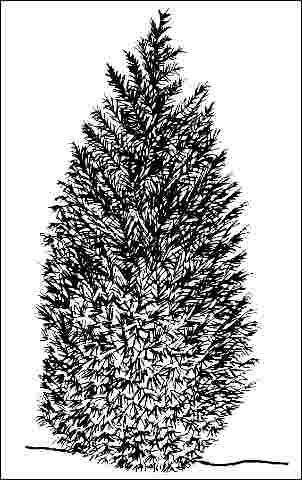Introduction
A moderate to rapidly growing evergreen when young, ‘Naylor's Blue' Leyland cypress will easily grow three feet per year, even on poor soils, and will ultimately attain a majestic height of 50 feet or more in the west, perhaps somewhat shorter in the east. Leyland cypress forms a dense, oval, or pyramidal outline when left unpruned, but the graceful, pendulous branches will tolerate severe trimming to create a formal hedge, screen, or windbreak. The fine, feathery glaucous blue-green foliage is composed of soft, pointed leaves on flattened branchlets and are dark blue-green when mature. Leyland cypress quickly outgrows its space in small landscapes and is too big for most residential landscapes unless it will be regularly trimmed. Although it can be sheared into a tall screen on small lots, Leyland cypress should probably be saved for large-scale landscapes where it can be allowed to develop into its natural shape.

Credit: UF/IFAS
General Information
Scientific name: x Hesperotropsis leylandii
Pronunciation: x hes-per-oh-trop-sis lay-LAN-dee-eye
Common name(s): 'Naylor's Blue' Leyland Cypress
Family: Cupressaceae
USDA hardiness zones: 6A through 10A (Figure 2)
Origin: not native to North America
Invasive potential: not assessed/incomplete assessment
Uses: specimen; screen; hedge; highway median; Christmas tree

Credit: UF/IFAS
Description
Height: 40 to 50 feet
Spread: 15 to 25 feet
Crown uniformity: symmetrical
Crown shape: oval, pyramidal, columnar
Crown density: dense
Growth rate: fast
Texture: fine
Foliage
Leaf arrangement: opposite/subopposite
Leaf type: simple
Leaf margin: entire
Leaf shape: scale-like
Leaf venation: none, or difficult to see
Leaf type and persistence: evergreen
Leaf blade length: less than 2 inches
Leaf color: blue or blue-green
Fall color: no color change
Fall characteristic: not showy
Flower
Flower color: no flowers
Flower characteristics: no flowers
Fruit
Fruit shape: round
Fruit length: less than .5 inch
Fruit covering: dry or hard
Fruit color: brown
Fruit characteristics: does not attract wildlife; not showy; fruit/leaves not a litter problem
Trunk and Branches
Trunk/bark/branches: branches don't droop; not showy; typically one trunk; thorns
Pruning requirement: little required
Breakage: resistant
Current year twig color: green
Current year twig thickness: thin
Wood specific gravity: unknown
Culture
Light requirement: full sun, partial sun, or partial shade
Soil tolerances: sand; loam; clay; acidic; alkaline; well-drained
Drought tolerance: high
Aerosol salt tolerance: moderate
Other
Roots: not a problem
Winter interest: no
Outstanding tree: yes
Ozone sensitivity: unknown
Verticillium wilt susceptibility: resistant
Pest resistance: sensitive to pests/diseases
Use and Management
Leyland cypress grows in full sun on a wide range of soils, from acid to alkaline, but looks its best on moderately fertile soil with sufficient moisture. It is surprisingly tolerant of severe pruning, recovering nicely from even severe topping (although this is not recommended), even when half the top is removed. It grows well in clay soil and tolerates poor drainage for a short period of time. It also is very tolerant of salt spray.
Some other cultivars include: ‘Castlewellan', a more compact form with gold-tipped leaves, excellent for hedges in cool climates; ‘Leighton Green', dense branching with dark green foliage, columnar form; ‘Haggerston Gray', loose branches, columnar-pyramidal, upturned at ends, sage-green color; ‘Silver Dust', wide-spreading form with blue-green foliage marked with white variegations.
Propagation is by cuttings from side growths.
Pests
Bagworm can defoliate a tree in a week or two and can be quite serious.
Diseases
A canker affects the tree following drought; a foliage fungus occasionally infects foliage. This plant is not recommended for planting in California due to the severity of this canker disease. Perhaps the disease will stay in the western United States.